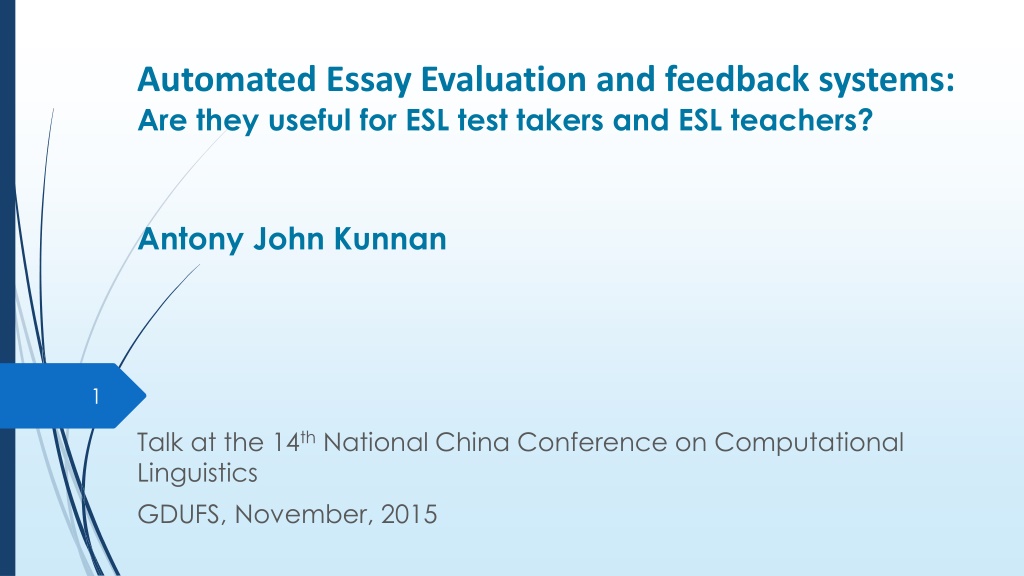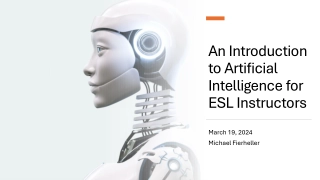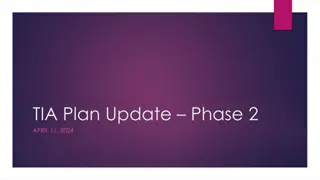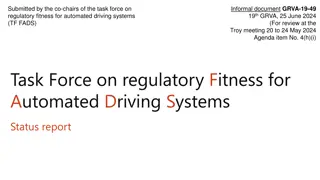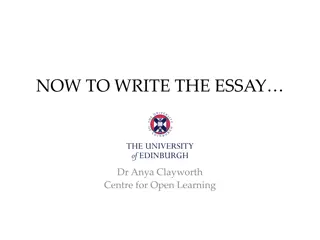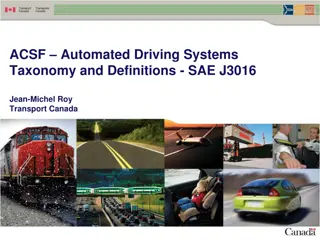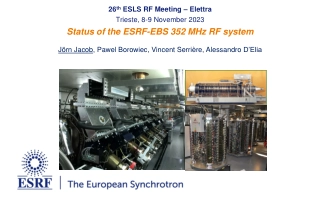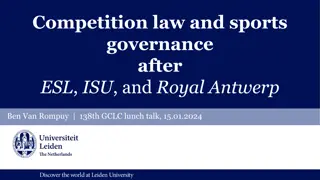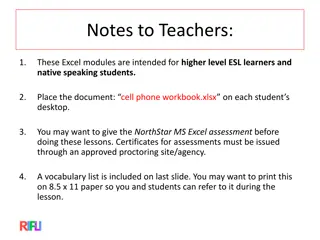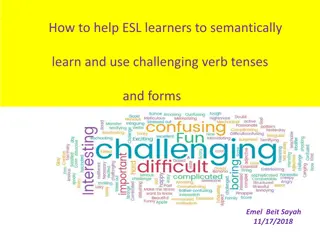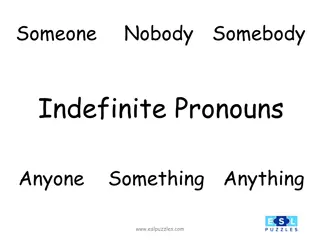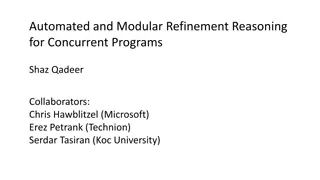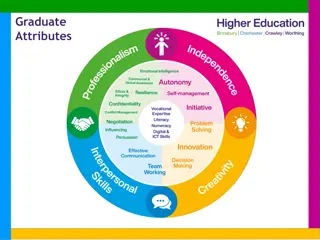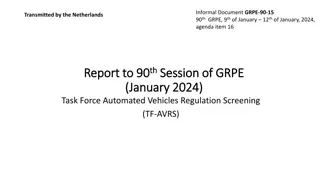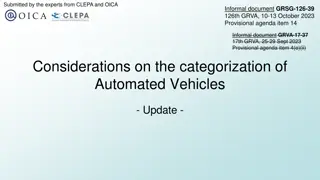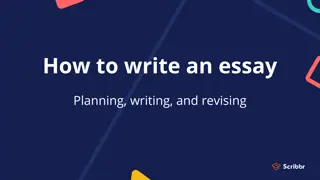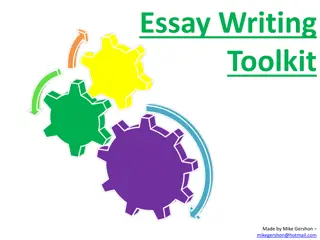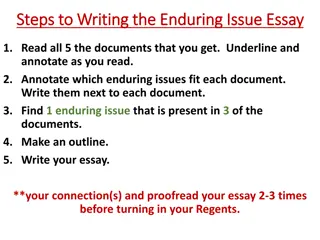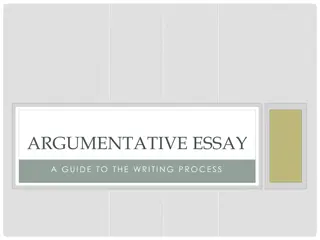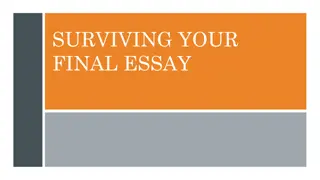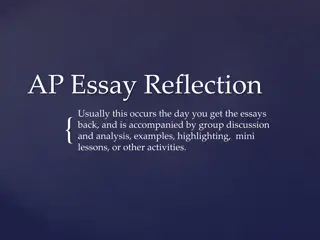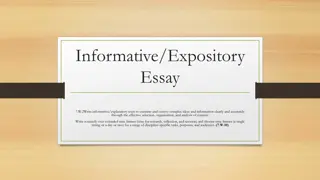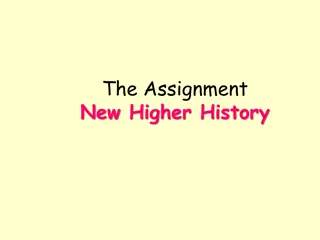Automated Essay Evaluation Systems in ESL Education
Automated Essay Evaluation (AES) systems are increasingly utilized in ESL education to provide automated scores and feedback on writing assignments. These systems employ mathematical models to assess organizational, syntactic, and mechanical aspects of writing, offering a shift from traditional essay grading methods. Various software tools like E-rater and Criterion Pearson's Intelligent Essay Assessor are employed for this purpose, showing promising results in enhancing motivation and writing skills among ESL test-takers. Research reports highlight successful applications of AES in different educational settings, indicating a growing trend in utilizing technology for language assessment and feedback.
- ESL education
- Automated Essay Evaluation
- Feedback systems
- Language assessment
- Educational technology
Download Presentation

Please find below an Image/Link to download the presentation.
The content on the website is provided AS IS for your information and personal use only. It may not be sold, licensed, or shared on other websites without obtaining consent from the author. Download presentation by click this link. If you encounter any issues during the download, it is possible that the publisher has removed the file from their server.
E N D
Presentation Transcript
Automated Essay Evaluation and feedback systems: Are they useful for ESL test takers and ESL teachers? Antony John Kunnan 1 Talk at the 14thNational China Conference on Computational Linguistics GDUFS, November, 2015
Part 1 2 Introduction
AES/AEE definition 3 Ware (2011, p. 769) defines two aspects of AES as 1. the provision of automated scores derived from mathematical models built on organizational, syntactic, and mechanical aspects of writing 2. automated feedback as computer tools for writing assistance 3. A major shift from essay scoring to essay evaluation; 4. A long way from Ellis Page s Project Essay Grade (PEG) developed in 1966 which was implemented in 1973
AEE and related software 4 Educational Testing Service, Princeton: E-rater and Criterion Pearson s Intelligent Essay Assessor; IEA and WriteToLearn Vantage s Intellimetric; IntelliMetric and MyAccess! William and Flora Hewlett s LightSIDE, Carnegie Mellon (Open source) BETSY (Open source) Autoscore, American Institutes of Research Bookette, CTB McGrawHill Intelligent Academic Discourse Evaluator (IADE) Lexile, MetaMetrics Coh-Metrix, Univ. of Tennessee (Open source): identifies textual features SourceRater: identifies the grade level of a text
Research reports of applications of AEE 5 Chen and Cheng (2008) in Taiwan Grimes and Warshauer (2010) in southern California Helps motivation WriteToLearn in South Dakota in school system Schultz in China West Virginia Writes (customized version of CTB s Writing Road Map, 2010
Example of AEE: E-rater (ETS) 6 E-rater uses NLP methods to identify construct-relevant linguistic properties in text. Statistical and rule-based methods are two approaches that are used with NLP tools to analyze texts. Statistical methods can be supervised (human annotated data human-scores essays) and unsupervised modeling (content vector analysis; for example, word frequency to evaluate similarity between two documents; example, Safe Assignment or Turnitin) Machine translation & Automated summarization (Columbia Univ. s NewsBlaster Internet search engines: Google, Yahoo!, Bing Automated question-answering: IBM s Watson for Jeopardy; Siri, Iris, etc.
E-rater features 7 Grammatical errors (e.g., Subject-verb agreement; their for there) using syntactic parsers; sentence fragments, determiner, preposition, etc.; statistical methods: parts of speech pairs, adjacent pairs Discourse structures/Organizational development (thesis, main points, supporting details, conclusions); presence of thesis idea, three longer main ideas more developed than only main idea Topic-relevant word usage (specialized topic vocabulary better than less specific words Style-related word usage (repeating words): collocations; NofN swarm of bees, Adj+N strong tea, N+N house arrest Register and word usage (powerful computer vs. strong computer)
E-rater Model building and advisories 8 Topic-specific models based on human score essays on a particular topic; need to have this data from hundreds of essays Generic models: based on human-scored essays written by test takers from the same populations from a number of essays; need data from thousands of essays Hybrid model like the generic model but across multiple topics
E-rater advisories 9 Off-topic essays Keyboard banging essays; aljsdhfeu aojfoerue aofjdajfjda Copied-prompt essays Unexpected-topic essays: misunderstood prompt or wrong question response: CVA method Bad-faith essays: chunks of text not related to the topic: CVA method Essay similarity: Chunks of text are unusual amounts of texts that are similar across prompts; maybe memorized chunks; checked with Essay Similarity Detector using NLP
Applications of E-rater, Bridgeman (2013) 10 For all essays in GRE, GMAT, TOEFL/iBT: One human rater + E-rater GRE example: Issue prompt type: difference between human and machine scores were quite small (d = .15) across the top 15 countries BUT the difference between human and machine scores for Chinese test takers were high (d= .60); higher scores from e-rater for 9000 cases Longer essays (they can get higher points from human and machine ratings Large chunks of memorized chunks; human raters see these as slightly off-topic but not completely off-topic and therefore will give low scores but machine scores cannot see the difference between off-topic and slightly off-topic For argument prompt type: difference between human and machine scores for Chinese test takers was high (d = .38) TOEFL example: the difference between human and machine scores for Chinese test takers was the highest for all countries (d= .25)
WriteToLearn: How LSA works (Foltz, Streeter, Lochbaum, & Landauer, 2013) 11 Uses a Latent semantic model (LSA) as a basis for scoring features Co-occurrence matrix of words and their usage in paragraphs Then reduces the matrix by Singular Value Decomposition like factor analysis Output is several hundred dimensional sematic space in which every word, paragraph, essay or document is represented by a vector of rea number to represent its meaning LSA derives measures of content, organization, and development-based features of writing A content score is assigned to an essay based on the scores of the most similar essays on semantic similarity scale Lexical sophistication, grammatical, mechanic, stylistic, and organizational aspects of essays is also assessed
WriteToLearn scoreboard 12 From Liu (2014)
WriteToLearn feedback 13 From Liu (2014)
MyAccess: How IntelliMetric works (Schultz, 2013) 14 Application of MyAccess on a Chinese essay prompt Data: 613 essays Topic: Environmental protection Sample essay: Shermis & Burstein (2103), p. 95 Correlations on training sample, N=493 Human-Human: r=.95 Human-MyAccess: r=.86 Correlations on validation sample, N=120 Human-Human: r=.96 Human-MyAccess: r=.93
Examples of problems 15 Chodorow et al., (2010): I fond car Misspelling found and a missing article: I found the car or missing preposition copula, preposition and plural marking: I am fond of cars ETS (website materials): Monkey see, monkey do subject/verb agreement errors but from a pragmatic perspective, the sentence is well formed evoking the world knowledge about monkey behavior and the use of provers in writing Weigle, 2013 He lead a good life subject/verb agreement error or a tense error Major syntax error
Part 2 16 AEE concerns and issues
Concerns about AEE (Shermis, Burstein & Bursky (2013) and Xi (2010) Can automated evaluation systems be gamed? Will the use of AEE foster attention to formal aspects of writing excluding richer aspects of the writing construct? Will AEE subvert the writing act fundamentally depriving the writer from a true audience? Are AEE/NLP systems/methods limited to superficial or literal linguistic analyses? Does the use of assessment tasks constrained by AEE technologies lead to construct under- or misrepresentation? (Domain representation) Do the AEE features under- or misrepresent the construct of interest? (Explanation) 17
On automated scoring and validation (Xi, 2010) 18 The way AEE features are combined to generate automated scores are they consistent with theoretical expectations of the relationships between the scoring features and the construct of interest? (Explanation) Does the use of AEE change the meaning and interpretation of scores provided by trained raters? Are the scores accurate indicators of the quality of a test performance sample? (Explanation) Would test taker s knowledge of the scoring algorithms of an AEE system impact the way they interact with the test tasks, thus negatively affecting the accuracy of the scores? (Evaluation) Does AEE yield scores that are sufficiently consistent across measurement contexts (e.g., across test forms, across tasks in the same form)? (Generalization)
On automated scoring and validation 2 (Xi, 2010) 19 Does AEE yield scores that have expected relationships with other test or non-test indicators of the targeted language ability? (Extrapolation) Do AEE lead to appropriate score-based decisions? (Utilization) Does the use of AEE have a positive impact on test taker s test preparation practices? (Utilization) Does the use of AEE have a positive impact on teaching and learning practices? (Utilization)
On automated feedback and validation (Xi, 2010) 20 Does the AEE system accurately identify learner performance characteristics or errors? (Evaluation) Does the AEE feedback system consistently identify learner performance characteristics or errors across performance samples? (Generalization) Is AEE feedback meaningful to students learning? (Explanation) Does AEE feedback lead to improvements in learners performances? (Utilization) Does AEE feedback lead to gains in targeted areas of language ability that are sustainable in the long term? (Utilization) Does AEE feedback have a positive impact on teaching and learning? (Utilization)
Some Common Human-Rater Errors and Biases (Zhang, 2013) 21 Severity/Leniency: Refers to a phenomenon when raters make judgments on a common dimension, but some raters consistently give high scores (leniency) while other raters consistently give low scores (severity), thereby introducing systematic biases. Scale Shrinkage: Occurs when human raters don t use the low and high ends on a scale. Inconsistency: Occurs when raters are either judging erratically, or along different dimensions, because of their different understandings and interpretations of the rubric. Halo Effect: Occurs when the rater s impression from one characteristic of an essay is generalized to the essay as a whole. Stereotyping: Refers to the predetermined impression that human raters may have formed about a particular group that can influence their judgment of individuals in that group. Perception Difference: Appears when immediately prior grading experiences influence a human rater s current grading judgments. Rater Drift: Refers to the tendency for individual or groups of raters to apply inconsistent scoring criteria over time.
Strengths and weaknesses (Zhang, 2013) 22 Human Raters Potential Measurement Strengths Are able to: Comprehend the meaning of the text being graded; Make reasonable and logical judgments on the overall quality of the essay Are able to incorporate as part of a holistic judgment: Artistic/ironic/rhetorical styles; Audience awareness; Content relevance (in depth); Creativity; Critical thinking; Logic and argument quality; Factual correctness of content and claims
Strengths and weaknesses (Zhang, 2013) 23 Potential Measurement Weaknesses Are subject to: Severity error; Scale shrinkage error; Inconsistency error; Halo effect; Stereotyping error; Perception difference error; Drift error; Subjectivity Logistical Weaknesses Will require: Attention to basic human needs (e.g., housing, subsistence level); Recruiting, training, calibration, and monitoring; Intensive direct labor and time
Strengths and weaknesses (Zhang, 2013) 24 Automated system Potential Measurement Strengths Are able to assess: Surface-level content relevance; Development; Grammar; Mechanics; Organization; Plagiarism; Limited aspects of style; Word usage Are able to more efficiently (than humans) provide Granularity (evaluate essays with detailed specifications with precision); Objectivity (evaluate essays without being influenced by emotions and/or perceptions); Consistency (apply exactly the same grading criteria to all submissions); Reproducibility (an essay would receive exactly the same score over time and across occasions from automated scoring systems); Tractability (the basis and reasoning of automated essay scores are explainable)
Strengths and weaknesses (Zhang, 2013) 25 Potential Measurement Weaknesses Are unlikely to: Have background knowledge; Assess creativity, logic, quality of ideas, unquantifiable features; directly assess cognitively demanding aspects of writing such as audience awareness, argumentation, critical thinking, and creativity And: Inherit biases/errors from human raters Logistical Strengths Can allow: Quick re-scoring; reduced cost (particularly in large-scale assessments); Timely reporting including possibility of instantaneous feedback Will require: Expensive system development; System maintenance and enhancement (indirect labor and time)
Part 3 26 Empirical studies
Applications 27 MyAccess Vantage learning; WriteToLearn - Pearson Automated scoring of writing tools like MyAccess and WriteToLearn also claim to be instructional tools by providing automated diagnostic feedback
Empirical studies 28 1. Consistency of scores Consistency evidence: Automated scoring Hoang & Kunnan (2015): MyAccess Liu & Kunnan (2015): WriteToLearn 2. Opportunity to Learn OTL evidence: Automated feedback Hoang & Kunnan (2015): MyAccess Liu & Kunnan (2015): WriteToLearn
Toulmins (1953) argumentation model (Kane, Bachman) 29 Claim OTL Meaningful Consistent Free of bias, etc. Grounds Fair and just support Warrants Qualifier presumably, possibly, etc. relevant claims Rebuttal evidence Backing evidence from empirical studies from empirical studies
MyAccess (Hoang & Kunnan, 2015) 30 Agreement between human raters and automated scoring Off-topic essays Comparisons between human feedback and automated feedback Data: ESL writers from Vietnam and California (N=105)
Human-MyAccess rating agreements, correlation, and difference; Hoang & Kunnan (2015) 31 _____________________________________________________________________________________________________ Human Rating 1 vs. Human Rating 2 _________________________________________________________________________ Cases % Exact agreement 10 9.5 Adjacent agreement 80 76.2 Disparate ratings 15 14.3 _________________________________________________________________________ Correlation MyAccess HRAVE .688 _________________________________________________________________________ Human Rating Average vs. MyAccess (MA) Cases % 2 1.9 73 69.5 30 28.6 Mean difference HR AVE Mean 3.76 SD 1.18 MyAccess 4.09* 1.19 N=105; * = p.<.05
Off-topic essays: Comparison of human and MyAccess ratings _________________________________________________ Essay HR 1 HR 2 MyAccess _________________________________________________ ESL1-4 2.5 1.0 ESL1-5 2.0 2.5 EFL1-37 2.3 3.5 EFL2-27 3.8 4.0 __________________________________________________ Notes: HR = Human Rating; scale is 0-6 points 32 4.9 4.2 4.0 4.6
Comparison between human and MyAccess feedback ______________________________________________________________________ Error type Human MyAccess feedback feedback ______________________________________________________________________ Spelling 7 2 Articles 124 32 Capitalization 38 19 Spelling 26 24 Run-ons 39 27 Preposition 36 9 Contractions 18 9 Punctuation 39 26 Fragments 25 16 S-V agreement 37 25 Word form 24 11 Mass/Count Ns 5 10 Wrong words 18 7 Comparatives 5 0 Total 465 252 184 33 MyAccess Precision Hits MyAccess Recall % % 2 31 17 20 22 7 7 20 12 18 4 3 2 0 100 96.9 89.5 83.3 81.5 77.8 77.8 76.9 75.0 72.0 36.4 30.0 28.6 0 72.4 39.6 28.6 25.0 44.7 76.9 56.4 19.4 38.9 51.3 48.0 48.6 16.7 60.0 11.1 0
WriteToLearn: Liu & Kunnan (2015) 34 Human raters and automated ratings on analytic scoring system Comparisons between human feedback and automated feedback Data: ESL writers from Sichuan province (N=186) Precision = Hits divided by software s total (For example, the precision of capitalization: 96 104 = 92.3); Recall = Hits divided by human feedback s total (For example, the recall of capitalization: 96 115 = 83.5).
Descriptive statistics for human ratings and WriteToLearn; Liu & Kunnan (2015) 35 HR1 HR2 HR3 HR4 WTL M SD M SD M SD M SD SD M Ideas 3.77 0.67 4.01 0.92 3.77 0.78 4.05 0.94 0.59 2.92 Organization 3.91 0.45 4.33 0.91 3.95 0.75 3.96 0.90 0.47 2.93 Conventions 4.02 0.32 4.03 1.06 3.66 0.90 3.80 0.85 3.74 0.64 3.52 0.64 4.06 0.99 3.62 0.75 3.92 0.90 3.63 0.65 Sentence Fluency Word Choice 3.34 0.58 3.87 0.90 3.48 0.76 3.88 0.79 3.40 0.58 Voice 3.80 0.51 3.96 0.98 3.70 0.77 3.75 0.91 3.04 0.63
Comparison between human and WriteToLearn feedback 36 Error type WriteToLearn s feedback Human rater s feedback Total Total Precision Hits Precision % Recall % 18 115 42 1 104 19 1 96 15 100.0 92.3 79.0 5.6 83.5 35.7 Connecting words Capitalization Subject-verb agreement Comma splice Singular/plural Article Run-on sentences Punctuation Spelling Pronoun 10 86 115 8 54 52 60 8 12 10 14 92 93 7 6 9 7 6 34 18 1 75.0 75.0 70.0 42.9 37.0 19.4 14.3 60.0 10.5 6.1 75.0 63.0 34.7 1.7 Other categories . Total 1032 394 193 48.9 18.7
Consistency: Hoang & Kunnan, 2015; Liu & Kunnan, 2015) 37 Sub-claim 1 MyAccess and WriteLearn are consistent in scoring Grounds An assessment ought to be fair to all test takers Warrants MyAccess and WriteLearn have high inter-rater consistency between human ratings and automated ratings Rebuttal Hoang & Kunnan: Exact and adj. agreement were only 71.4%; r = .688; mean diff between HR and MA ratings (sig.) Liu & Kunnan: WTL severe in ratings on ideas, organization and voice; and overall (+0.95 logits); separation between severe raters is 18.42 (sig.) Backing Liu & Kunnan: Reliability 1.00; infit and outfit (1.01 and 1.02 logits) Observed exact agreement among raters (37.8%); expected agreement (37.7%).
Opportunity to Learn: Hoang & Kunnan, 2015; Liu & Kunnan, 2015 38 Sub-claim 2 MyAccess and WriteLearn provide adequate opportunity to learn Grounds An assessment ought to be fair to all test takers Warrants Automated scoring systems (My Access and WritetoLearn) provide comparable diagnostic feedback to human diagnostic feedback Rebuttal Off topic essays consistently receive high ratings (over 4.0) from My Access compared to human ratings (1.0 to 4.0). Comparison of human annotations and My Access s shows 73% in precision and 39.6% in recall Comparison of human annotations and WritetoLearn s shows 49% in precision and 18.7% in recall. Backing Precision hits and %s are moderately high (73%) although it does not meet the threshold of 90%.
Part 4 39 Summary, conclusion & references
Summary 40 What AEE can do Parse sentences Identify propositions What AEE cannot do Relate propositions to world knowledge Judge the strength or reasonableness of support for an argument Evaluate authorial voice Assumptions shared between author and reader Allusions to literature, people or events Relate to humor or irony or general pragmatics
Practical findings 41 In terms of scoring, use human scoring along with automated scoring software; not to use automated scoring all by itself Provide transparent lists of features and algorithms for scoring to stakeholders In terms of feedback, human assessors (teachers) should re-interpret or restate error feedback from the automated feedback
Evaluating systems: Arguments from philosophy 42 Main theoretical perspectives and proponents: Utilitarianism (outcomes-based; Bentham, Mill) Social contract/deontology (duty-based; Kant, Rawls, Sen) The Trolley problem (Foot, 1967) illustration: 5 v. 1: two different tracks 5 v. 1: 1 fat man on the track 5 v. 1: 5 transplants v. 1 healthy person
Final thought 43 Once a new technology rolls over you, if you are not part of the steamroller, you are part of the road - Stewart Brand, in Whole Earth, 2012
Selected references 44 Hoang, G., & Kunnan, A. J. (in press). Automated writing instructional tool for English language learners: A case study of MyAccess. Language Assessment Quarterly. Liu, S. & Kunnan, A. J. (in press). Automated scoring of writing: A case study of WriteToLearn. CALICO journal. Shermis, M. & Burstein, J. (2013). Handbook of automated essay evaluation. Mahwah, NJ: Routledge.
45 The end Thank You! For more details, see: www.antonykunnan.com
